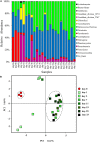Succession and Fermentation Products of Grass Carp (Ctenopharyngodon idellus) Hindgut Microbiota in Response to an Extreme Dietary Shift
- PMID: 28871246
- PMCID: PMC5566599
- DOI: 10.3389/fmicb.2017.01585
Succession and Fermentation Products of Grass Carp (Ctenopharyngodon idellus) Hindgut Microbiota in Response to an Extreme Dietary Shift
Abstract
Dietary intake affects the structure and function of microbes in host intestine. However, the succession of gut microbiota in response to changes in macronutrient levels during a long period of time remains insufficiently studied. Here, we determined the succession and metabolic products of intestinal microbiota in grass carp (Ctenopharyngodon idellus) undergoing an abrupt and extreme diet change, from fish meal to Sudan grass (Sorghum sudanense). Grass carp hindgut microbiota responded rapidly to the diet shift, reaching a new equilibrium approximately within 11 days. In comparison to animal-diet samples, Bacteroides, Lachnospiraceae and Erysipelotrichaceae increased significantly while Cetobacterium decreased significantly in plant-diet samples. Cetobacterium was negatively correlated with Bacteroides, Lachnospiraceae and Erysipelotrichaceae, while Bacteroides was positively correlated with Lachnospiraceae. Predicted glycoside hydrolase and polysaccharide lyase genes in Bacteroides and Lachnospiraceae from the Carbohydrate-Active enZymes (CAZy) database might be involved in degradation of the plant cell wall polysaccharides. However, none of these enzymes was detected in the grass carp genome searched against dbCAN database. Additionally, a significant decrease of short chain fatty acids levels in plant-based samples was observed. Generally, our results suggest a rapid adaption of grass carp intestinal microbiota to dietary shift, and that microbiota are likely to play an indispensable role in nutrient turnover and fermentation.
Keywords: SCFAs; freshwater fish; gut microbiota; high-fiber diet; high-protein diet.
Figures




Similar articles
-
Metatranscriptomic discovery of plant biomass-degrading capacity from grass carp intestinal microbiomes.FEMS Microbiol Ecol. 2015 Oct;91(10):fiv107. doi: 10.1093/femsec/fiv107. Epub 2015 Sep 10. FEMS Microbiol Ecol. 2015. PMID: 26362922
-
Gut segments outweigh the diet in shaping the intestinal microbiota composition in grass carp Ctenopharyngodon idellus.AMB Express. 2019 Apr 6;9(1):44. doi: 10.1186/s13568-019-0770-0. AMB Express. 2019. PMID: 30955112 Free PMC article.
-
Altered gut microbiota associated with intestinal disease in grass carp (Ctenopharyngodon idellus).World J Microbiol Biotechnol. 2018 May 18;34(6):71. doi: 10.1007/s11274-018-2447-2. World J Microbiol Biotechnol. 2018. PMID: 29777414
-
Effects of Dietary Administration of Shewanella xiamenensis A-1, Aeromonas veronii A-7, and Bacillus subtilis, Single or Combined, on the Grass Carp (Ctenopharyngodon idella) Intestinal Microbiota.Probiotics Antimicrob Proteins. 2017 Dec;9(4):386-396. doi: 10.1007/s12602-017-9269-7. Probiotics Antimicrob Proteins. 2017. PMID: 28321827
-
Effect of Diet Supplemented With Rapeseed Meal or Hydrolysable Tannins on the Growth, Nutrition, and Intestinal Microbiota in Grass Carp (Ctenopharyngodon idellus).Front Nutr. 2019 Sep 25;6:154. doi: 10.3389/fnut.2019.00154. eCollection 2019. Front Nutr. 2019. PMID: 31608284 Free PMC article.
Cited by
-
Comparative Study of the Gut Microbiota Community between the Farmed and Wild Mastacembelus armatus (Zig-Zag Eel).Metabolites. 2022 Nov 29;12(12):1193. doi: 10.3390/metabo12121193. Metabolites. 2022. PMID: 36557231 Free PMC article.
-
Effects of a Microbial Restoration Substrate on Plant Growth and Rhizosphere Microbial Community in a Continuous Cropping Poplar.Microorganisms. 2023 Feb 15;11(2):486. doi: 10.3390/microorganisms11020486. Microorganisms. 2023. PMID: 36838451 Free PMC article.
-
Establishment and characterization of a competitive exclusion bacterial culture derived from Nile tilapia (Oreochromis niloticus) gut microbiomes showing antibacterial activity against pathogenic Streptococcus agalactiae.PLoS One. 2019 May 3;14(5):e0215375. doi: 10.1371/journal.pone.0215375. eCollection 2019. PLoS One. 2019. PMID: 31050668 Free PMC article.
-
Microbiome of Co-cultured Fish Exhibits Host Selection and Niche Differentiation at the Organ Scale.Front Microbiol. 2019 Nov 8;10:2576. doi: 10.3389/fmicb.2019.02576. eCollection 2019. Front Microbiol. 2019. PMID: 31781072 Free PMC article.
-
Feeding strategy and feed protein level affect the gut microbiota of common carp (Cyprinus carpio).Environ Microbiol Rep. 2024 Jun;16(3):e13262. doi: 10.1111/1758-2229.13262. Environ Microbiol Rep. 2024. PMID: 38725141 Free PMC article.
References
-
- Bergman E. N. (1990). Energy contributions of volatile fatty-acids from the gastrointestinal-tract in various species. Physiol. Rev. 70 567–590. - PubMed
-
- Biddle A., Stewart L., Blanchard J., Leschine S. (2013). Untangling the genetic basis of fibrolytic specialization by Lachnospiraceae and Ruminococcaceae in diverse gut communities. Diversity 5 627–640. 10.3390/d5030627 - DOI
-
- Brulc J. M., Antonopoulos D. A., Miller M. E. B., Wilson M. K., Yannarell A. C., Dinsdale E. A., et al. (2009). Gene-centric metagenomics of the fiber-adherent bovine rumen microbiome reveals forage specific glycoside hydrolases. Proc. Natl. Acad. Sci. U.S.A. 106 1948–1953. 10.1073/pnas.0806191105 - DOI - PMC - PubMed
LinkOut - more resources
Full Text Sources
Other Literature Sources
Molecular Biology Databases
Research Materials

